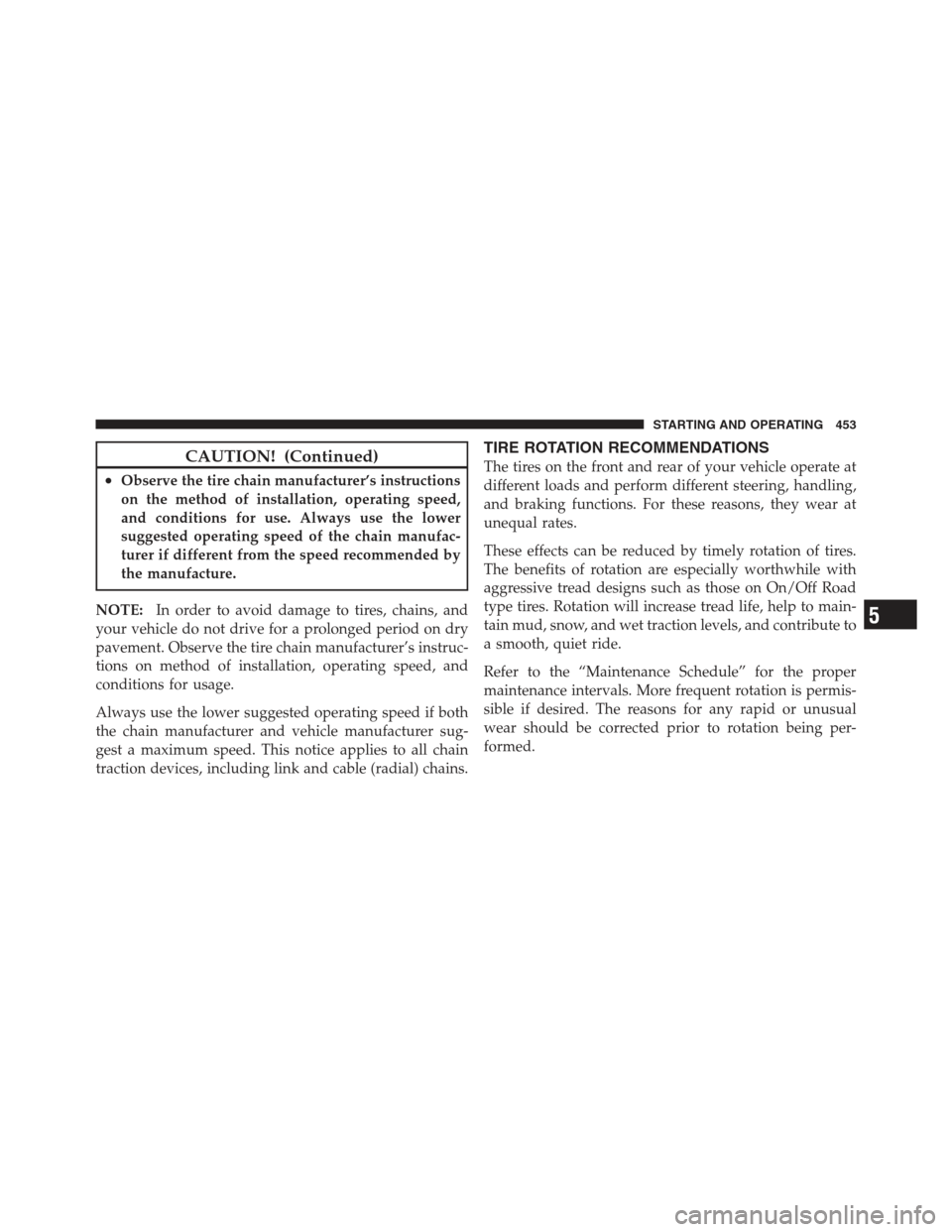Page 429 of 613
When in�Partial Off� mode, the TCS portion of ESC has
been disabled and the “ESC Activation/Malfunction
Indicator Light” will be illuminated. All other stability features of ESC function normally. This
mode is intended to be used if the vehicle is in deep
snow, sand, or gravel conditions and more wheel spin
than ESC would normally allow is required to gain
traction. To turn ESC on again, momentarily press the
ESC OFF switch. This will restore the normal “ESC On”
mode of operation.
NOTE:
To improve the vehicle’s traction when driving
with snow chains, or starting off in deep snow, sand, or
gravel, it may be desirable to switch to the “Partial Off”
mode by pressing the ESC OFF switch. Once the situation
requiring ESC to be switched to the “Partial Off” mode is
overcome, turn ESC back on by momentarily pressing the
ESC OFF switch. This may be done while the vehicle is in
motion.
ESC OFF Switch
5
STARTING AND OPERATING 427
Page 455 of 613

CAUTION! (Continued)
•Observe the tire chain manufacturer’s instructions
on the method of installation, operating speed,
and conditions for use. Always use the lower
suggested operating speed of the chain manufac-
turer if different from the speed recommended by
the manufacture.
NOTE: In order to avoid damage to tires, chains, and
your vehicle do not drive for a prolonged period on dry
pavement. Observe the tire chain manufacturer’s instruc-
tions on method of installation, operating speed, and
conditions for usage.
Always use the lower suggested operating speed if both
the chain manufacturer and vehicle manufacturer sug-
gest a maximum speed. This notice applies to all chain
traction devices, including link and cable (radial) chains.
TIRE ROTATION RECOMMENDATIONS
The tires on the front and rear of your vehicle operate at
different loads and perform different steering, handling,
and braking functions. For these reasons, they wear at
unequal rates.
These effects can be reduced by timely rotation of tires.
The benefits of rotation are especially worthwhile with
aggressive tread designs such as those on On/Off Road
type tires. Rotation will increase tread life, help to main-
tain mud, snow, and wet traction levels, and contribute to
a smooth, quiet ride.
Refer to the “Maintenance Schedule” for the proper
maintenance intervals. More frequent rotation is permis-
sible if desired. The reasons for any rapid or unusual
wear should be corrected prior to rotation being per-
formed.
5
STARTING AND OPERATING 453
Page 460 of 613

extinguish once the updated tire pressures have been
received. The vehicle may need to be driven for up to
20 minutes above 15 mph (24 km/h) to receive this
information.
The “Tire Pressure Monitoring Telltale Light” will flash
on and off for 75 seconds, and will remain on solid when
a system fault is detected. The system fault will also
sound a chime. If the ignition key is cycled, this sequence
will repeat, providing the system fault still exists. A
system fault can occur by any of the following scenarios:
1. Jamming due to electronic devices or driving next to
facilities emitting the same Radio Frequencies as the TPM
sensors.
2. Installing some form of aftermarket window tinting
that affects radio wave signals.
3. Lots of snow or ice around the wheels or wheel
housings.4. Using tire chains on the vehicle.
5. Using wheels/tires not equipped with TPM sensors.
NOTE:
•If your vehicle is equipped with a matching full-size
spare wheel and tire assembly, it has a tire pressure
monitoring sensor, and can be monitored by the Tire
Pressure Monitoring System (TPMS). In the event that
the matching full-size spare tire is swapped with a low
pressure road tire, the next ignition key cycle will still
show the “Tire Pressure Monitoring Telltale Light” to
be ON, and a chime to sound. Driving the vehicle for
up to 20 minutes above 15 mph (24 km/h) will turn
OFF the “Tire Pressure Monitoring Telltale Light” as
long as none of the road tires are below the low
pressure warning threshold.
•If your vehicle is not equipped with a matching
full-size spare wheel and tire assembly, it does not
have a tire pressure monitoring sensor in the spare tire.
458 STARTING AND OPERATING
Page 608 of 613

Shoulder Belt Upper Anchorage.............. 53
Shoulder Belts ........................... 46
Side Airbag ............................. 65
Side Window Demisters (Defrosters) .......... 365
Signals, Turn ................. 89,151,270,557,558
Snow Chains (Tire Chains) ................. 452
Soft Top ........................... 194,219
Spare Tire ....................... 447,448,495
Specifications Fuel (Gasoline) ...................... 460
Oil ............................... 519
Speed Control (Cruise Control) .............. 159
Speedometer ........................... 269
Starting ............................... 372
Automatic Transmission ................ 372
Cold Weather ....................... 373
Engine Block Heater .................. 375
Engine Fails to Start .................. 373
Manual Transmission .................. 372 Remote
............................ 26
Steering Power .......................... 412,413
Tilt Column ........................ 158
Wheel, Tilt ......................... 158
Steering Wheel Audio Controls .............. 352
Steering Wheel Mounted Sound System
Controls .............................. 352
Storage ............................ 169,554
Storage, Behind the Seat ................... 169
Storage, Vehicle ...................... 364,554
Storing Your Vehicle ...................... 554
Stuck, Freeing .......................... 505
Sunrider ........................... 247,250
Supplemental Restraint System - Airbag ........ 58
Sway Bar Disconnect, Electronic ............. 396
Swing Gate, Rear ......................... 42
System, Remote Starting .................... 26
606 INDEX